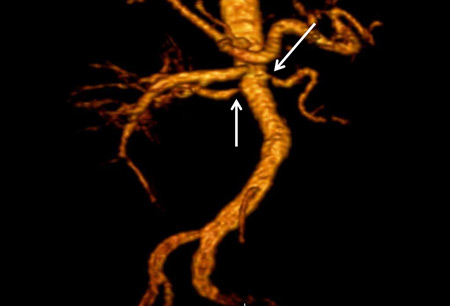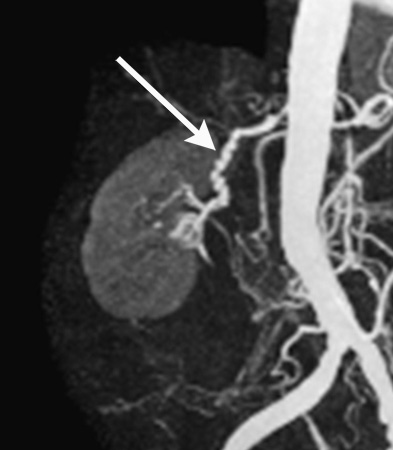Epidemiology
RAS has a prevalence of 0.2% to 5% in all hypertensive patients.[7]
Epidemiology depends on the underlying cause:
Atherosclerotic RAS accounts for 90% of all RAS.[1][8][9] Prevalence is as high as 25% in patients with coronary artery disease undergoing cardiac catheterization.[2]
Two percent of end-stage renal disease (ESRD) is due to ischemic nephropathy.[10][Figure caption and citation for the preceding image starts]: Magnetic resonance angiography (3-dimensional volume rendered reconstruction) in a patient with significant bilateral atherosclerotic renal artery stenosis. Arrows indicate proximal bilateral stenosesCourtesy of David J. Sheehan, DO; Radiology Department, University of Massachusetts Medical Center and Medical School [Citation ends].

Fibromuscular dysplasia accounts for 10% of clinical RAS.[11] Females are 2 to 10 times more likely than males to be diagnosed with this form of RAS.[2][11] Onset typically occurs before the age of 30.[2][11][Figure caption and citation for the preceding image starts]: Magnetic resonance angiography (maximum-intensity projection) in a patient with fibromuscular dysplasia of the renal arteries. Arrow indicates the characteristic irregular contour in the right renal arteryCourtesy of Raul Galvez, MD, MPH and Hale Ersoy, MD; Department of Radiology, Brigham and Women’s Hospital, Harvard Medical School [Citation ends].

RAS is uncommon in children. One retrospective US study found the majority of cases of pediatric RAS to be idiopathic (60.5%), with middle aortic syndrome and fibromuscular dysplasia representing the most common nonidiopathic etiologies.[12]
Use of this content is subject to our disclaimer